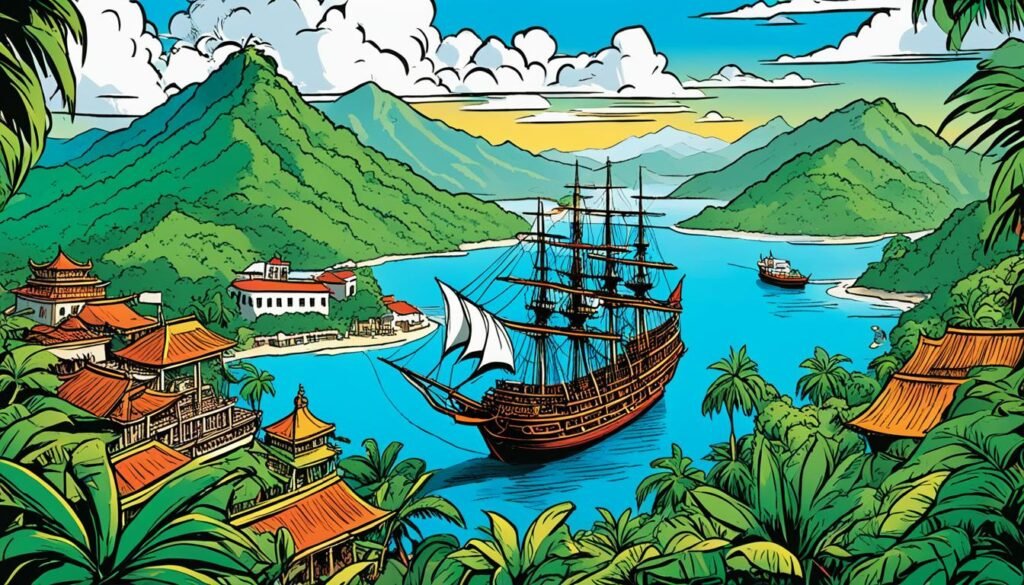Spanish colonization of the Philippines had a profound impact on the country’s natural resources and environment. Over the course of three centuries, the Spanish introduced economic policies and practices that transformed the Philippine economy but also led to detrimental consequences. Deforestation, loss of biodiversity, and environmental degradation were key outcomes of Spanish colonization.
The concentration of land ownership and monopolization of trade by the Spaniards contributed to social disparity and the decline of local industries. As the Spanish exploited the Philippines’ resources for their economic gain, the consequences were significant. Additionally, the introduction of new species by the Spanish had negative environmental effects, disrupting local ecosystems.
Despite the negative impact, the Philippines has recognized the importance of sustainable development and natural resource protection. Efforts have been made in recent years to strike a balance between economic progress and environmental sustainability, ensuring the long-term well-being of the country.
Key Takeaways:
- Spanish colonization had a profound impact on the Philippines’ natural resources and environment.
- The Spanish introduced economic policies that transformed the Philippine economy but also led to deforestation, loss of biodiversity, and environmental degradation.
- The concentration of land ownership and monopolization of trade by the Spanish contributed to social disparity and the decline of local industries.
- The Spanish also exploited the Philippines’ resources for their economic gain and introduced new species that had negative environmental effects.
- The Philippines is now focused on sustainable development and natural resource protection as part of their efforts towards a balanced approach.
The Dawn of Spanish Influence: Transformative Economic Policies and Practices
The Spanish colonization of the Philippines brought about significant changes in the country’s economic landscape. Through the introduction of various policies and practices, the Spanish left an indelible mark on the Philippine economy, shaping its trajectory for centuries to come.
Introduction of the Encomienda System
One of the key economic policies implemented by the Spanish was the Encomienda System. Under this system, large tracts of land were granted to Spanish settlers, known as encomenderos. These encomenderos were granted the right to extract tribute from the local population, mainly in the form of labor or agricultural produce. This system resulted in the concentration of land ownership in the hands of the Spanish elite, while the indigenous communities were subjected to exploitation and forced labor.
Establishment of the Galleon Trade
The establishment of the Galleon Trade was another transformative economic practice introduced by the Spanish. This trade route connected the Philippines with Acapulco, Mexico, facilitating the exchange of goods between Asia and the Americas. The Galleon Trade allowed for the export of Philippine goods such as silk, spices, and porcelain, while silver from Mexico flowed back into the Philippines. While the trade contributed to the growth of the Philippine economy, it also brought about a decline in local industries as the focus shifted towards the production of goods for export.
Legacy of the Hacienda System
The Spanish also instituted the Hacienda System, which involved the development of large-scale agricultural estates owned by Spanish landlords. These haciendas became centers for agricultural production, with the sugar industry being a prominent example. While the growth of the sugar industry brought economic benefits, it also led to the exploitation of workers and environmental degradation. The Hacienda System perpetuated social inequality, as the Spanish landlords held significant power and control over the land and resources.
The Spanish influence in the Philippines through their economic policies and practices left a lasting impact. The Encomienda System, Galleon Trade, and Hacienda System all played pivotal roles in shaping the colonial economy. However, these practices also led to social disparity, exploitation of indigenous communities, the decline of local industries, and environmental degradation.
Despite the challenging legacy of Spanish colonization, the Philippines has taken steps towards sustainable development and natural resource protection in recent years. Efforts to strike a balance between economic progress and environmental sustainability are crucial for the country’s future.
Environmental Paradigm Shifts: From Deforestation to Loss of Biodiversity
The Spanish colonization had profound environmental impacts on the Philippines, resulting in significant paradigm shifts. Two key factors contributed to these shifts: the excessive use of forest resources for shipbuilding and the cultivation of cash crops, both of which had severe ecological consequences.
Excessive Use of Forest Resources for Shipbuilding
The demand for timber by Spanish expeditions and the shipbuilding industry led to widespread deforestation in the Philippines. Forests were extensively cleared to meet the needs of the growing colonial infrastructure. As a result, the country experienced soil erosion, loss of biodiversity, and changes in climate patterns. The depletion of forests had long-lasting environmental impacts and affected the natural balance of ecosystems.
Cash Crop Cultivation and Ecological Consequences
To support the Spanish economy, cash crops like tobacco and sugar cane were cultivated in the Philippines. However, the cultivation of these crops required the conversion of forests into agricultural land, further exacerbating environmental degradation. Deforestation for cash crop cultivation led to water pollution, soil degradation, and habitat loss for native species. The introduction of these non-native crops also disrupted existing ecological systems, affecting the overall biodiversity of the Philippines.

Environmental Impact of Spanish Colonization
| Environmental Impact | Description |
|---|---|
| Deforestation | Extensive clearing of forests for shipbuilding and cash crop cultivation, resulting in soil erosion, habitat loss, and climate changes. |
| Loss of Biodiversity | Conversion of forests into agricultural land led to the displacement of native species, decreased biodiversity, and disrupted ecological systems. |
| Soil Degradation | Intensive agricultural practices, such as monoculture, contributed to soil erosion, nutrient depletion, and decreased agricultural productivity. |
| Water Pollution | Runoff from agricultural activities and the use of chemicals in cash crop cultivation resulted in water pollution and degradation of aquatic ecosystems. |
These paradigm shifts, driven by the excessive use of forest resources and cash crop cultivation, had lasting environmental consequences for the Philippines. The impacts of deforestation and loss of biodiversity are still felt today, underscoring the need for sustainable practices and environmental conservation efforts in the country.
Ripple Effects of Colonial Economy on Philippine Society
The colonial economy established by the Spanish had significant ripple effects on Philippine society. The concentration of land ownership among the Spanish elite and the introduction of a feudal system led to social disparity, with the majority of the population facing economic marginalization. The monopolization of trade by the Spanish authorities further contributed to the decline of local industries, as high taxes and tariffs were imposed on Philippine goods. These economic disparities and the decline of local industries have had lasting impacts on Philippine society and continue to shape socio-economic dynamics in the country.
Concentration of Land Ownership and Social Disparity
The Spanish colonial period in the Philippines witnessed a significant concentration of land ownership among the Spanish elite. Large tracts of land were controlled by a few wealthy families, while the majority of the population had limited access to land and resources. As a result, social disparity and economic marginalization became prevalent in Philippine society. Indigenous communities, in particular, experienced displacement from their ancestral lands, leading to further social and economic inequalities.
Monopolization of Trade and Local Industry Decline
Under Spanish rule, trade in the Philippines was heavily monopolized by the Spanish authorities. They imposed high taxes and tariffs on Philippine goods, making it difficult for local industries to compete in the international market. As a result, many local industries experienced a decline, leading to loss of jobs and economic opportunities for the local population. The monopolization of trade had far-reaching effects on the Philippine economy, hindering its development and contributing to the country’s economic dependence on foreign powers.
In summary, the colonial economy established by the Spanish in the Philippines had profound ripple effects on Philippine society. The concentration of land ownership and the monopolization of trade led to social disparity and the decline of local industries. These effects continue to resonate in contemporary Philippine society, shaping socio-economic dynamics and perpetuating economic inequalities. It is essential to understand the historical context of these ripple effects to fully comprehend the challenges faced by the Philippines in achieving a more inclusive and equitable society.
Deep-Rooted Impacts on Philippines’ Environment and Natural Wealth
The Spanish colonization of the Philippines had profound and deep-rooted impacts on the country’s environment and natural wealth. As the Spanish sought to exploit the Philippines’ resources for their economic gain, they engaged in extensive resource exploitation, leading to the depletion of forests, minerals, and other valuable resources. The consequences of this resource exploitation are still felt today, with the Philippines facing environmental challenges and the loss of its natural wealth.
Resource exploitation was a key component of the Spanish economic agenda in the Philippines. The Spanish colonizers exploited the country’s rich timber, minerals, and agricultural produce to meet their economic demands. The extraction of resources for Spanish economic gain resulted in the depletion of forests, leading to deforestation, soil erosion, and the loss of biodiversity. The extensive mining activities resulted in the depletion of valuable minerals, impacting the geological and ecological balance of the land.
Furthermore, the Spanish introduced new species to the Philippines, such as cattle and pigs, which had significant environmental impacts. These introduced species competed with native species for food and habitat, leading to disruptions in ecosystems and the introduction of diseases that affected local wildlife. The introduction of non-native species had negative effects on the delicate balance of the Philippine ecosystem, contributing to the loss of biodiversity and the disruption of natural habitats.
This extensive resource exploitation and the introduction of new species have left lasting and deep-rooted impacts on the Philippines’ environment and natural wealth. The depletion of natural resources and the disruption of ecosystems have had far-reaching consequences for the country’s ecological balance and its ability to sustainably manage its natural wealth.

Maintaining Economic Progress Amidst Environmental Degradation
The Philippines has encountered significant challenges in achieving and sustaining economic progress while simultaneously grappling with the consequences of environmental degradation caused by Spanish colonization. The rapid growth of the country’s economy has amplified the pressure on its natural resources and environment, necessitating concerted efforts to promote sustainable development and prioritize environmental protection.
Various initiatives have been implemented to strike a balance between economic progress and environmental sustainability. One such initiative is the promotion of sustainable tourism, which seeks to optimize economic benefits while minimizing negative impacts on the environment. By enforcing responsible travel practices and implementing effective waste management strategies, the Philippines aims to preserve its natural attractions and ensure the long-term viability of its tourism industry.
Eco-friendly agriculture is another crucial aspect of the country’s sustainable development efforts. By fostering agricultural practices that minimize harm to the environment and preserve natural resources, the Philippines aims to maintain a sustainable food production system while mitigating the ecological consequences of intensive farming methods.
The government has also put in place policies focused on natural resource protection to safeguard its invaluable ecosystems. These policies include regulations on mining and logging, reforestation programs, and measures to protect endangered species. By enacting strict controls and promoting responsible resource management, the government strives to strike a harmonious balance between economic development and the preservation of its natural heritage.
Efforts to maintain economic progress amidst environmental degradation are vital for ensuring the long-term well-being and sustainability of the Philippines. By prioritizing sustainable development and natural resource protection, the country can work towards a future where economic growth coexists harmoniously with the preservation of its invaluable natural wealth.
Sustainable Approaches to Reconciling Economic and Environmental Priorities
Efforts in Sustainable Tourism
The Philippines has recognized the importance of sustainable tourism in reconciling economic and environmental priorities. Through responsible travel practices, the country aims to minimize negative impacts on the environment and local communities. By limiting the number of visitors to sensitive areas, implementing waste management strategies, and safeguarding natural attractions, the Philippines is committed to preserving its unique ecosystems and cultural heritage. Sustainable tourism not only promotes environmental conservation but also contributes to the socio-economic development of local communities, creating opportunities for job creation and economic growth.
Advancements in Eco-Friendly Agriculture
Another key sustainable approach in the Philippines is the advancement of eco-friendly agriculture. Recognizing the importance of preserving natural resources and promoting biodiversity, the country has been investing in agricultural practices that minimize environmental harm. These practices include organic farming, crop rotation, and the use of natural pest control methods. By adopting eco-friendly agriculture, the Philippines aims to ensure long-term food security, protect ecosystems, and reduce the reliance on chemical inputs. This approach not only benefits the environment but also supports the health and well-being of farmers and consumers.

Government Policies on Natural Resource Protection
The Philippine government has implemented various policies aimed at protecting the country’s natural resources. Regulations on mining and logging practices seek to minimize the negative environmental impacts of resource extraction. Reforestation programs are in place to restore and preserve forest ecosystems, enhancing biodiversity and mitigating climate change. Moreover, the government has prioritized the protection of endangered species through the establishment of conservation areas and initiatives to combat illegal wildlife trade. These comprehensive government policies on natural resource protection reflect the commitment to sustainable development and ensure the preservation of the Philippines’ natural wealth for future generations.
The Inextricable Link: Spain’s Economic Imperatives and Philippine Natural Resources
The economic imperatives of Spain had a profound impact on the natural resources of the Philippines during the colonial period. Spanish colonization introduced new crops to the country, such as tobacco and sugar cane, which had significant economic impacts. These cash crops became major exports, contributing to the growth of the Philippine economy. The introduction of new crops reshaped the agricultural landscape, bringing about changes in land ownership and power dynamics.
New Crops and Their Economic Impacts
The introduction of tobacco and sugar cane revolutionized the agricultural sector in the Philippines. These crops became profitable commodities that fueled economic growth. Tobacco cultivation provided significant revenue as Spanish authorities established a tobacco monopoly in the colony. The Philippine tobacco industry thrived under Spanish control and became a major source of revenue for the colonial government. Similarly, the cultivation of sugar cane boomed, with Spanish landlords establishing haciendas and employing local workers to cultivate and process the crop. The sugar industry grew rapidly and became a profitable export commodity.
The economic impacts of these new crops were substantial. They stimulated trade and commerce, created employment opportunities, and generated revenue for the Spanish colony. However, the economic benefits of these cash crops were not evenly distributed. The concentration of land ownership among the Spanish elite and Filipino landlords resulted in the exploitation of the local workforce and perpetuated social and economic disparities.
The Restructuring of Land and Power Dynamics
The introduction of new crops brought about significant changes in land ownership and power dynamics in the Philippines. Spanish landowners and Filipino elites acquired vast tracts of land to cultivate cash crops. The concentration of land ownership in the hands of the few, combined with the exploitative practices used on haciendas, deepened social inequalities and exacerbated the marginalization of the majority of the population.
The restructuring of land ownership also had a direct impact on power dynamics. The Spanish elite and Filipino landlords gained significant influence and control over the economic and political landscape of the colony. This concentration of power further marginalized the native Filipinos and facilitated the exploitation of their labor and resources by the ruling class.
The relationship between Spain’s economic imperatives and the natural resources of the Philippines was inextricable. The introduction of new crops transformed the agricultural sector and fueled economic growth, but also entrenched social and economic inequalities. The concentration of land ownership and the accompanying power dynamics shaped the colonial society and had lasting effects on the socio-economic fabric of the Philippines.
Understanding the Historical Context: The Principalía and its Role in Natural Resources Management
To understand the impact of Spanish colonization on natural resources management in the Philippines, it is essential to consider the historical context of the Principalía. The Principalía refers to the traditional Filipino elite who played significant roles in Spanish colonial society. They were granted privileges and authority by the Spanish colonizers, acting as intermediaries between the colonial government and the local population.
The Principalía had a role in natural resources management, as they were involved in the administration and exploitation of resources. They played a crucial part in the decision-making process regarding resource utilization and distribution. The Principalía’s position allowed them to exert influence over policies and practices related to natural resources, shaping the management strategies employed during the Spanish colonial period.
This historical context provides insights into the power dynamics and resource control that occurred under Spanish colonization. It highlights the role of the Principalía as key actors in natural resources management, although their involvement was often driven by the interests of the Spanish colonizers. Understanding the historical context of the Principalía is crucial for comprehending the complexities of natural resources management during this period and its lasting effects on the Philippines’ environment and socio-economic landscape.
Unpacking the Manila Galleon Trade and its Economic Significance
The Manila Galleon Trade played a crucial role in Spanish colonization and had significant economic significance for the Philippines. As a colonial income source, it brought wealth to the Spanish through the exchange of Mexican silver for Chinese goods. The trade route connected Manila with Acapulco in Mexico, facilitating the exchange of goods between Asia and the Americas. The Manila Galleon Trade not only contributed to the growth of the Philippine economy but also brought about cultural exchange and economic benefits through the Manila-Acapulco route. This trade route fostered connections between the East and the West, impacting both economic and cultural dynamics.

The Manila Galleon Trade was a vital source of income for the Spanish during their colonization of the Philippines. The trade involved the exchange of valuable goods, particularly Mexican silver, for goods from China. This influx of silver into the Spanish colonial coffers fueled economic growth and stability in the Philippines.
Besides its economic significance, the Manila Galleon Trade also played a pivotal role in cultural exchange. The trade route served as a vital link between Asia and the Americas, facilitating the exchange of goods, ideas, and traditions. The Philippines became a melting pot of diverse cultures, with influences from China, Spain, Mexico, and other regions.
The Manila-Acapulco route forged connections between the East and the West, contributing to the global trade network of the time. It fostered economic cooperation, cultural interaction, and knowledge exchange between different regions of the world. The benefits of this cultural exchange can still be observed in the Philippines today, with Spanish and Chinese influences deeply embedded in Philippine culture, cuisine, and traditions.
Consequences of Private Land Ownership Established by the Spanish
The establishment of private land ownership by the Spanish in the Philippines had profound consequences for the country. This shift from communal land to private ownership had far-reaching implications for resource control and social inequality.
Shift from Communal to Private Land
Under Spanish colonization, indigenous communities were forcibly displaced from their ancestral lands, and large tracts of land were concentrated in the hands of Spanish colonizers and Filipino elites. This marked a significant departure from the traditional communal land ownership practiced by indigenous groups, where land was considered a shared resource for the entire community.
Implications for Resource Control and Social Inequality
The concentration of land ownership in the hands of a few privileged individuals resulted in the exploitation of resources for economic gain. Spanish colonizers and Filipino elites used their control over vast lands to extract wealth and dominate various industries, including agriculture and natural resource extraction. This led to increased social inequality, as power and wealth became concentrated in the hands of a select few, while the majority of the population experienced economic marginalization.
The consequences of private land ownership established by the Spanish continue to shape resource control and social dynamics in the Philippines to this day. The legacy of unequal land distribution and resource exploitation has contributed to persistent social and economic disparities in the country.

Conclusion
The Spanish colonization of the Philippines had a profound impact on the country’s natural resources and environment. The economic policies and practices introduced by the Spanish transformed the Philippine economy but also resulted in significant environmental degradation. Deforestation and loss of biodiversity were major consequences of the Spanish exploitation of resources for their economic gain.
The concentration of land ownership and monopolization of trade by the Spanish had lasting effects on Philippine society. These factors contributed to social disparity and the decline of local industries, further exacerbating the negative impacts of colonization. Additionally, the introduction of new species by the Spanish had detrimental effects on the Philippines’ ecosystems, leading to environmental pressures and changes in wildlife populations.
However, in recent years, the Philippines has taken significant steps towards sustainable development and natural resource protection. Sustainable approaches in tourism, agriculture, and government policies have been implemented to reconcile economic progress with environmental sustainability. These efforts aim to ensure the long-term well-being of the Philippines’ economy and environment, mitigating the negative impacts of Spanish colonization.
Despite the historical challenges posed by Spanish colonization, the Philippines remains determined in its pursuit of a balanced approach that prioritizes the preservation and wise management of its natural resources. Through sustainable development practices and a commitment to environmental protection, the country is working towards a future that harmonizes economic progress with the preservation of its unique natural heritage.
FAQ
What was the impact of Spanish colonization on the Philippines’ natural resources and environment?
Spanish colonization had a profound impact on the Philippines’ natural resources and environment. The introduction of economic policies and practices led to deforestation, loss of biodiversity, and environmental degradation. The exploitation of resources for economic gain and the introduction of new species also had negative environmental effects.
What were the transformative economic policies and practices introduced by the Spanish?
The Spanish introduced several transformative economic policies and practices during their colonization of the Philippines. These included the implementation of the Encomienda System, the establishment of the Galleon Trade, and the development of the Hacienda System.
How did the Encomienda System impact the Philippines?
The Encomienda System granted large tracts of land to Spanish settlers who extracted tribute from the local population. This concentration of land ownership led to the exploitation of indigenous communities and a shift in power dynamics.
What was the significance of the Galleon Trade?
The Galleon Trade connected Manila with Acapulco, Mexico, allowing for the export of Philippine goods and the import of goods like silver. While it contributed to the growth of the Philippine economy, it also brought about a decline in local industries and economic independence.
How did the Hacienda System impact the Philippines?
The Hacienda System involved the development of large-scale agricultural estates owned by Spanish landlords, leading to the growth of the sugar industry. However, it also resulted in the exploitation of workers and environmental degradation.
What were the environmental paradigm shifts caused by Spanish colonization?
Spanish colonization led to significant environmental paradigm shifts in the Philippines. Excessive use of forest resources for shipbuilding resulted in deforestation, soil erosion, and loss of biodiversity. The cultivation of cash crops also led to ecological consequences such as water pollution and soil degradation.
How did Spanish colonization impact Philippine society?
The concentration of land ownership among the Spanish elite and the monopolization of trade contributed to social disparity and the decline of local industries. These economic disparities continue to shape socio-economic dynamics in the country.
How did the Spanish exploit the Philippines’ resources?
The Spanish exploited the Philippines’ resources, including timber, minerals, and agricultural produce, for their economic gain. This resource exploitation led to the depletion of forests and other valuable resources.
What were the sustainable approaches implemented by the Philippines to address the impact of Spanish colonization?
The Philippines has implemented sustainable approaches such as initiatives in sustainable tourism, eco-friendly agriculture, and government policies on natural resource protection. These efforts aim to balance economic development with environmental sustainability.
What were the economic imperatives of Spain and how were they linked to the natural resources of the Philippines?
The economic imperatives of Spain were linked to the natural resources of the Philippines. The introduction of new crops like tobacco and sugar cane had significant economic impacts and reshaped the agricultural landscape.
What was the role of the Principalía in natural resources management during Spanish colonization?
The Principalía, the traditional Filipino elite, played roles in natural resources management as intermediaries between the colonial government and the local population. They were involved in the administration and exploitation of resources.
What was the significance of the Manila Galleon Trade?
The Manila Galleon Trade served as a colonial income source, bringing wealth to the Spanish through the exchange of Mexican silver for Chinese goods. It fostered connections between the East and the West and had cultural and economic significance.
What were the consequences of private land ownership established by the Spanish in the Philippines?
The shift from communal to private land ownership had implications for resource control and social inequality. Indigenous communities were displaced, and large tracts of land were concentrated in the hands of Spanish colonizers and Filipino elites.


